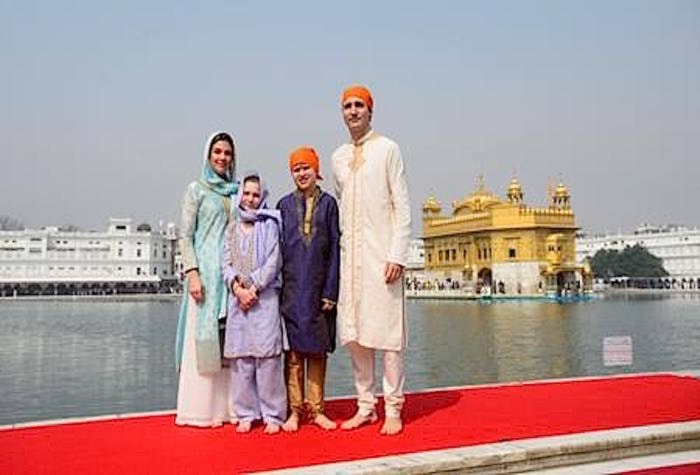TORONTO — The traditional garb that Prime Minister Justin Trudeau and his family have adopted in India has raised eyebrows around the world, but travel experts say that shouldn’t dissuade Westerners from trying to honour local norms when they head overseas.
Canada’s first family appeared in relatively demure attire as Trudeau donned a suit to tour one of India’s largest mosques Thursday, with wife Sophie in a yellow floral dress and their kids in matching striped button-downs.
And a meeting with Prime Minister Narendra Modi on Friday saw Canada’s leader in a similarly straight suit and tie.
Nevertheless, criticism lingered over past fashion choices, which included an elaborate gold sherwani that Trudeau wore to a dinner with Bollywood stars including Shah Rukh Khan, Anupam Kher and Aamir Khan — who all wore dark suits.
It followed other family photo ops in which the quintet — including 10-year-old Xavier, nine-year-old Ella-Grace, and three-year-old Hadrien — appeared in co-ordinating kurtas with their hands in the namaste pose.
“Is it just me or is this choreographed cuteness all just a bit much now? Also FYI we Indians don’t dress like this every day sir, not even in Bollywood,” Omar Abdullah, former chief minister of Jammu and Kashmir, tweeted from his verified account Tuesday.
Harry Sharma of the Canada-India Centre for Excellence calls the criticism “unfair,” believing that most Indians were not offended by anything the Trudeaus have worn or done: “Indians actually appreciate when there’s an extra effort made to appreciate their culture and their clothing and all of those things.”
“In India, it’s not unusual for visiting dignitaries to wear Indian clothes,” adds the Indian-born Sharma, director of an organization that focuses on bilateral trade and business opportunities between the two countries.
“I know that anytime there are senior diplomats who go, or senior leaders who go, they do wear ethnic clothes there.”
Still, he allows that it can be difficult for a foreigner to know what not to wear. Sharma says the general rule of thumb is for men to wear a suit and tie for business engagements.
“But national dress is always welcome at important events and I can tell you there’s a good portion of the Indian population that actually prefers Indian clothing over the normal suit that we wear in the West,” he adds.
Non-Indian women, meanwhile, should not wear a sari to a business meeting, even if that’s the attire of their female hosts, he says.
“When you’re doing business you’re not talking about the culture, you’re more talking about the business opportunities,” says Sharma, adding that non-Indian women can don a sari for social events.
“It’s not necessary to show that you understand the culture. What you need to show is that you’re a savvy businessperson.”
Sleeveless dresses are generally accepted, but he suggests bringing along a blazer and/or a scarf as coverup, nonetheless.
When it comes to non-official engagements, men also have more leeway.
“There is the traditional kurta pyjama that men wear that (Trudeau) has been wearing. There are some modified versions of it so if it’s a non-official engagement, a non-business engagement, then it’s absolutely appropriate to wear that.”
The Trudeaus’ eight-day visit has been dogged by various controversies since it began Feb. 17, but it’s their apparent fashion faux-pas that has seized some arm-chair critics and raised questions about whether they’ve crossed a cultural line.
History professor Ritu Birla says the intense scrutiny points to how much politics has become enmeshed with celebrity culture.
However, she allows that it is possible to be seen as “too authentic.”
“Our interest as Westerners is to be sensitive to foreign cultures … but part of that sensitivity is to know that there are different norms. People wear different things, there are different understandings of what gender norms are and what is respectful,” says the Indian-born culture expert, noting that the family donned various traditional outfits that ranged in formality.
“But going too far (can) foreclose listening.”
If you’re unsure of the local customs, Birla suggests to research in advance. If you are invited to an event, don’t be afraid to ask the host what is expected of you.
Birla, who was raised in New York and now splits her time with Toronto, learned that the hard way several years ago when she brought an elegant black-and-white designer sari to her cousin’s wedding overseas. It was only when she arrived that she learned the colours black and white are verboten at Indian weddings.
“If you are new to the culture then it is important to pay attention to the meaning of colour on certain occasions, in the same way you wouldn’t wear a bright red dress to a funeral here in the West,” says Birla, an instructor with the University of Toronto’s Munk School of Global Affairs.
“Try to find that balance between paying attention to cultural difference but not turning cultural difference into a costume.”
And Birla won’t dissuade tourist from buying a sari on vacation and wearing it: “Travelling it is about inhabiting a place in different ways of being, and if fashion allows you to do that then that’s wonderful.”
“My problem is when those ways of being become commodified and stand in for a whole range of worldviews, regional perspectives, local perspectives and norms.”
Still, Birla admits it’s hard to know what else the Trudeaus could have done.
“There really isn’t very much other choice because celebrity is about branding,” she notes. “In order to sell the Canadian brand you have to embrace the Indian brand.”
Cassandra Szklarski, The Canadian Press
